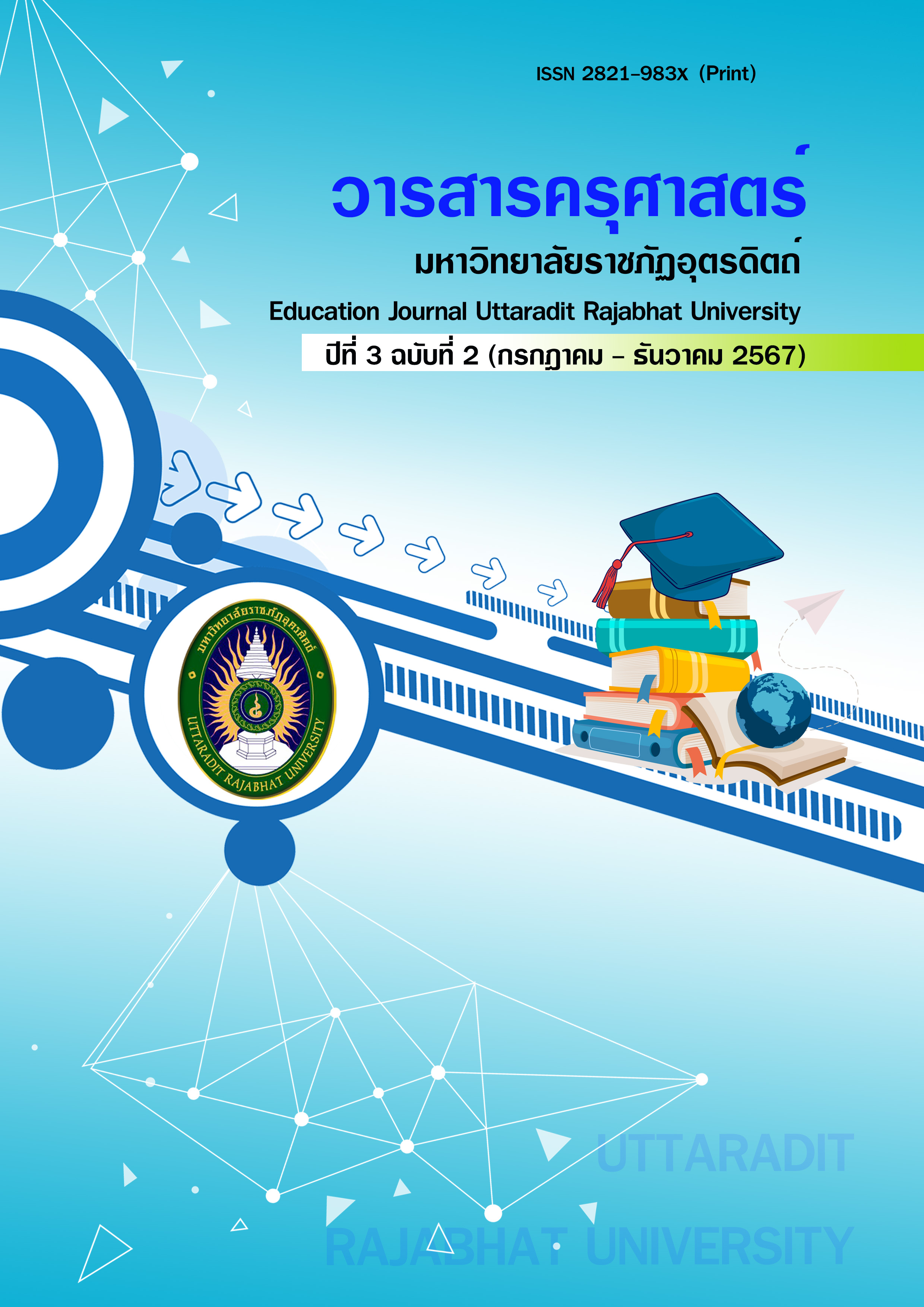Development of Mathematics Learning Achievement Using the Think-Pair-Share Technique on the Topic of Properties of Exponents for Mathayom 2 students
Main Article Content
Abstract
This study aimed to achieve three objectives: 1) to develop a mathematics learning plan using the Think-Pair-Share technique on the topic of properties of exponents, 2) to compare the learning achievement of mathematics using the Think-Pair-Share technique on the topic of properties of exponents against the 70% benchmark, and 3) to investigate the satisfaction of Grade 8 students with the learning management using the Think-Pair-Share technique. The sample group consisted of Grade 8 students from Ban Lao Pa Sa School. The tools used for data collection included: 1) learning plans, 2) a post-test measuring knowledge after learning, and 3) a questionnaire evaluating students' satisfaction with the learning plan using the Think-Pair-Share technique. Statistical analyses included mean, standard deviation, percentage, and t-test.
Results of the study revealed the following:
- The evaluation of the mathematics learning plan using the Think-Pair-Share technique on the topic of properties of exponents indicated that students achieved an average score of 78.025% based on the learning objectives. Additionally, the students' post-test scores averaged 78%. Thus, it can be concluded that the mathematics learning plan using the Think-Pair-Share technique met the 70/70 efficiency criteria.
- The learning achievement of students on the topic of properties of exponents, facilitated through the Think-Pair-Share technique, was significantly higher than the 70% benchmark at the 0.05 level of statistical significance.
- The overall satisfaction of Grade 8 students with the learning management using the Think-Pair-Share technique was at the highest level, with a mean score of 4.93 ± 0.687. All evaluation criteria indicated the highest level of satisfaction.
Keywords: Think-Pair-Share technique; properties of exponents
Article Details

This work is licensed under a Creative Commons Attribution-NonCommercial-NoDerivatives 4.0 International License.
Faculty of Education Journal Uttaradit Rajabhat University It is a medium for disseminating research results. Academic work Any opinions expressed in the article are solely the personal opinions of the author. Faculty of Education Uttaradit Rajabhat University and the editorial team does not necessarily have opinions that are consistent with those expressed in the article in any way. and is not considered the responsibility of the Faculty of Education Uttaradit Rajabhat University and editorial team
References
กาจวาที ประทุมแสง. (2562). การพัฒนาแผนการจัดการเรียนรู้ผ่านเครือข่ายสังคมออนไลน์ โดยใช้ เทคนิคเพื่อนคู่คิดวิชาหลักการตลาด นักศึกษาระดับปริญญาตรี มหาวิทยาลัยราชภัฏชัยภูมิ. มหาสารคาร : มหาวิทยาลัยราชภัฏมหาสารคาม.
กฤติยา ปลงสนิท. (2561). ผลการใช้ชุดกิจกรรมการเรียนรู้ภาษาอังกฤษเพื่อการสื่อสารเทคนิคเพื่อนคู่คิด สำหรับนักเรียนชั้นประถมศึกษาปีที่ 5. ชัยภูมิ : มหาวิทยาลัยราชภัฏชัยภูมิ.
คณะกรรมการการศึกษาขั้นพื้นฐาน. (2560).หลักสูตรแกนกลางการศึกษาขั้นพื้นฐาน, 2551 (ฉบับปรับปรุง พ.ศ. 2560). กรุงเทพฯ : กระทรวงศึกษาธิการ.
ทิศนา แขมมณี. (2560). ศาสตร์การสอน: องค์ความรู้เพื่อการจัดกระบวนการเรียนรู้ที่มีประสิทธิภาพ(พิมพ์ครั้งที่ 8). กรุงเทพฯ : แห่งจุฬาลงกรณ์มหาวิทยาลัย.
ปฏิญญา โกมลกิติสกุล. (2565). การพัฒนาความสามารถด้านการอ่านจับใจความของนักเรียนชั้นมัธยมศึกษา ปีที่ 2 ด้วยการจัดการเรียนรู้แบบ OK5R ร่วมกับเทคนิคเพื่อนคู่คิด. การค้นคว้าอิสระ สาขาวิชาภาษาไทย. บัณฑิตวิทยาลัย: มหาวิทยาลัยนเรศวร.
ปิยวรรณ ผลรัตน์. (2560). การพัฒนาความสามารถในการแก้ปัญหาทางคณิตศาสตร์ ของนักเรียนชั้นมัธยมศึกษาปีที่ 3 เรื่อง อสมการ โดยใช้รูปแบบ SSCS ร่วมกับเทคนิคเพื่อนคู่คิด. วิทยานิพนธ์ปริญญาวิทยาศาสตรมหาบัณฑิต. บัณฑิตวิทยาลัย: มหาวิทยาลัยเทคโนโลยีพระจอมเกล้าธนบุรี.
ผกาวดี จันทร์วัฒนพงษ์. (2565). การจัดการเรียนรู้โดยใช้บทเรียนคณิตศาสตร์ เรื่อง เศษส่วนและทศนิยมด้วยรูปแบบการจัดการเรียนรู้ SSCS ร่วมกับเทคนิคเพื่อนคู่คิด สำหรับนักเรียนชั้นประถมศึกษาปีที่ 5. การประชุมวิชาการระดับชาติด้านวิทยาศาสตร์และเทคโนโลยีเครือข่ายสถาบันอุดมศึกษาภาคใต้ ครั้งที่ 7. มหาวิทยาลัยราชภัฎสุราษฎร์ธานี.

